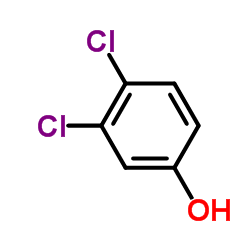Disappearance kinetics of 2,4- and 3,4-dichlorophenol in a fluvial system.
J H Carey, M E Fox, B G Brownlee, J L Metcalfe, R F Platford
Index: Can. J. Physiol. Pharmacol. 62(8) , 971-5, (1984)
Full Text: HTML
Abstract
The disappearance rates of 2,4- and 3,4-dichlorophenol in a small stream were studied and were shown to be first order with respect to either distance or time of flow. Both chlorophenols disappeared at approximately the same rate with average half-lives in the stream of about 4 h. The absence of seasonal variability in the rate constants along with the observance of first order kinetics over several ecological zones of the stream led to the conclusion that the rate controlling factor was not biological. It is suggested that the disappearance was due to degradation within the biofilm covering the stream bed and that the rate is controlled by diffusion of the chlorophenols across the water-biofilm interface.
Related Compounds
| Structure | Name/CAS No. | Molecular Formula | Articles |
|---|---|---|---|
 |
3,4-Dichlorophenol
CAS:95-77-2 |
C6H4Cl2O |
|
Microbial degradation of xenobiotic, aromatic pollutants in ...
1988-07-01 [Appl. Environ. Microbiol. 54(7) , 1864-7, (1988)] |
|
Oxidation of 2,4-dichlorophenol and 3,4-dichlorophenol by me...
2011-02-01 [Water Res. 45(5) , 2038-48, (2011)] |
|
Regiospecific dechlorination of pentachlorophenol by dichlor...
1991-08-01 [Appl. Environ. Microbiol. 57(8) , 2293-301, (1991)] |
|
In Silico Improvement of beta3-peptide inhibitors of p53 x h...
2009-05-13 [J. Am. Chem. Soc. 131(18) , 6356-7, (2009)] |
|
Effect of ambient oxygen concentration upon the acute toxici...
1992-10-01 [Ecotoxicol. Environ. Saf. 24(2) , 131-43, (1992)] |